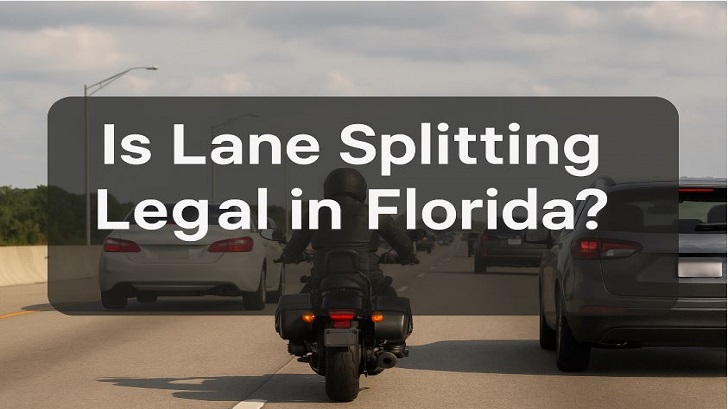- Michael Burry
- Jun 17, 2025
No, lane splitting is not legal in Florida, according to Florida Statutes § 316.209. It states that no person will operate a motorcycle between traffic lanes, vehicle rows, or adjacent lines.
Motorcycles are subject to the same traffic laws and Florida driving regulations as other motor vehicles. Motorcycles can operate in their own lane, but they cannot drive between traffic lanes or adjacent rows of vehicles. You must know the Florida motorcycle laws to avoid severe consequences.
Not all states allow lane-splitting, and in those that do, the specific regulations may differ. Certain conditions, such as traffic moving below a certain speed limit or safe and responsible motorcycle operation, allow lane-splitting in some areas.
What is lane-Splitting?
Lane splitting is riding a motorcycle between two lanes of slow-moving or stopped traffic. A motorcycle operator drives their vehicle in the gap between the two lanes of cars, trucks, or other vehicles, passing through congested traffic more quickly.
The practice of lane-splitting can be controversial, with some arguing that it is a dangerous maneuver that puts motorcyclists and other motorists at risk of accidents and injuries. Lane-splitting can improve traffic flow and reduce congestion on crowded roads.
Typical Injuries Sustained in a Motor Vehicle Accident in Florida
Some of the common injuries sustained after an auto accident are as follows:
- Whiplash
- Broken bones
- Head trauma
- Spinal cord injuries
- Burns
- Soft tissue injuries
- Internal injuries
- Emotional and psychological injuries
Is lane-Splitting Dangerous?
If done improperly or in prohibited situations, lane-splitting can be dangerous. When motorcycles drive between lanes of traffic, they are in a high-risk situation and may be at greater risk of accidents and injuries.
Lane-splitting can be dangerous due to various factors.
-
Limited space: The space between lanes of traffic may be narrow, leaving little room for error or evasive maneuvers.
-
Limited visibility: Other motorists may not be able to see motorcycles driving between lanes, which can lead to collisions or near-misses.
-
Increased speed differential: If motorcycles drive much faster than the surrounding traffic, they may be at greater risk of accidents or collisions.
-
Sudden lane changes: If a car or truck suddenly changes lanes, the motorcyclist may not have time to react, leading to a collision.
-
Limited margin for error: In any high-risk driving situation, there is a limited margin for error, which means that any mistake or misjudgment can quickly lead to an accident.
What are the Penalties for Lane Splitting in Florida?
In Florida, the criminal penalty for lane splitting is a fine of up to $500 and points on a driver’s license. If a police officer determines that the motorcyclist's actions include reckless driving, other charges are possible.
The Benefits and Risks of Lane Splitting
If the motorcycle moves between lanes instead of stopping due to traffic, drivers will not hit it from the rear end. This is one of the benefits of lane splitting. However, there are also risks in lane splitting.
Sometimes, the driver may not be able to see a motorcycle rider between the lanes. They may even lose control of their motorcycle and cause an accident. Lane splitting is illegal in most of the United States because the risks outweigh the benefits.
Who is at Fault in a Lane-Splitting Accident in Florida?
Whoever breaks the law is presumed to be at fault in an accident. However, the presumption is not the final verdict. The other driver may also have done something dangerous that caused the collision, resulting in injuries or disabilities.
How Does Lane Splitting Affect Your Injury Claim?
If a victim files a motorcycle accident claim, lane splitting may impact their right to get compensation. This is effective whether you are on a motorcycle or in some other vehicle involved in a collision. You can file a claim and recover financial compensation for losses from liable parties who caused the crash. You may only receive reimbursement for monetary damages if the following are true:
- Other drivers have a duty to exercise care on the road.
- The other driver was acting negligently, meaning the motorist behaved less safely than anyone else would in such circumstances.
- The main cause of the accident was the other driver’s negligence.
- The accident caused the victim's injuries.
If a motorcyclist engages in a lane splitting in an illegal state, it will be negligent behavior, and the injury claim may not be successful.
Is Lane Filtering Legal?
Lane filtering is a practice associated with lane splitting, which is when a motorcyclist moves back and forth between the lines of slow-moving or stopped traffic. In the case of lane filtering, the motorcyclist tends to stay in the middle of the lane and moves up through the lines of halted or slow-moving vehicles.
Just as with lane splitting, lane filtering is illegal in the state of Florida. The state’s traffic regulations do not make a significant distinction between lane splitting and lane filtering; both are banned under the same law. This implies that motorcyclists practicing lane filtering are subject to the same penalties as those caught lane splitting, including fines and the possibility of increased liability in the case of an accident in Florida.
Comparative Negligence V/S Contributory Negligence in Lane Splitting Claims
A lane-splitting motorcyclist is partly at fault for causing the collision, which involved illegal and unsafe practices. However, obtaining compensation for the claim will depend entirely on Florida traffic laws.
In some states, contributory negligence prevails. In this negligence, the motorist, whether blamed partly for causing the injuries or not, will not claim to recover damages.
In most states, comparative negligence prevails. According to these laws, a motorcyclist who is partly at fault for the accident can obtain compensation from drivers who are to blame. In some states, a victim's fault must be less than 50% or 51% responsible for the crash. Under the comparative fault rules, there must be a reduction in damages on the basis of the percentage of fault or severity of injuries to the victim.
Let’s understand this with an example. Let's say a motorcyclist, who sustained $100,000 in damages and contributed 40% to the motorcycle accident due to lane splitting, can obtain $60,000 from another driver who bears the blame.
How Can a lawyer Help if You are Injured in a Motorcycle Accident?
Lane-splitting accidents can be complex due to the prevailing Florida lane-splitting laws. If you sustain injuries in a motorcycle lane-splitting accident, it may be beneficial to work with a motorcycle accident lawyer. They may assist you in recovering damages for medical expenses, lost wages, pain and suffering, and other losses as a result of the accident.
FAQs on Lane Splitting
1. Why is lane splitting illegal in Florida?
Because it can lead to accidents due to reckless driving, lane splitting is illegal in Florida. Although it is popular among motorcycle riders, it is considered illegal in Florida.
2. In Florida, how much is the ticket for lane splitting?
A ticket for lane splitting in Florida can result in a penalty of up to $500. The police officer may also impose other charges if they find the driver driving recklessly or distracted.
3. Is lane splitting legal at a red light in Florida?
As we know, lane splitting is illegal in Florida. When a motorcyclist drives between two vehicles and splits two travel lanes to pass them, it happens. However, California commonly permits motorcycle riders to do this only if they do not exceed the speed limit.
4. In Florida, what is the difference between lane filtering and lane splitting?
Lane filtering and splitting are often used interchangeably. However, the fundamental difference between the two is in traffic conditions. Lane splitting occurs when traffic is slow or stops, whereas lane filtering occurs when traffic is stationary.
5. Is white-lining legal in Florida?
White lining, popularly known as stripe riding, permits motorcyclists to bypass slow or stopped traffic. Although the practice may tempt motorcycle riders, it is illegal in Florida.
6. In a Florida motorcycle accident claim, what is liability?
A rider, another driver, or both parties involved in an accident can be held liable. Some factors that play a significant role in determining liability are road conditions, traffic violations, and vehicle malfunctions.
7. How Long Does It Take To File A Motorcycle Accident Lawsuit In Florida?
In Florida, the statute of limitations for filing a motorcycle accident lawsuit is two years from the date the accident occurred.



